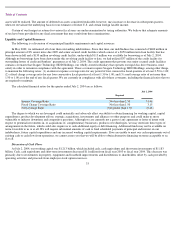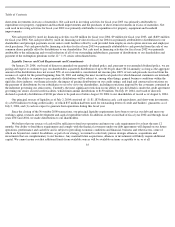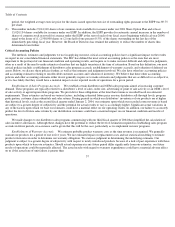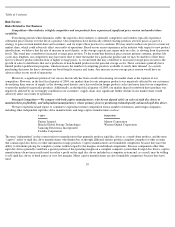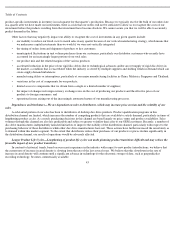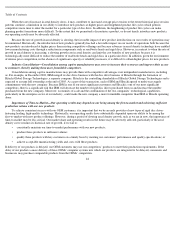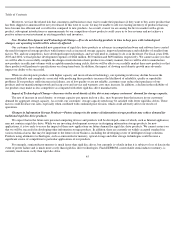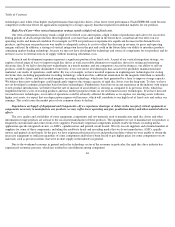Seagate 2003 Annual Report Download - page 38
Download and view the complete annual report
Please find page 38 of the 2003 Seagate annual report below. You can navigate through the pages in the report by either clicking on the pages listed below, or by using the keyword search tool below to find specific information within the annual report.
Table of Contents
period, the weighted average exercise price for the shares issued upon the exercise of outstanding rights pursuant to the ESPP was $9.75
per share.
Critical Accounting Policies
(3)
This number includes 9,014,310 shares of our common stock available for issuance under our 2001 Share Option Plan and at least
15,020,134 shares available for issuance under our ESPP. In addition, the ESPP provides for automatic annual increases in the number of
shares of common stock reserved for issuance under the ESPP at the start of each of our fiscal years (beginning with fiscal year 2004)
equal to the lesser of (1) 2,500,000 shares or (2) one half of one percent (0.5%) of the shares outstanding on the last day of the
immediately preceding fiscal year. However, the Board of Directors has retained the authority to reduce the number of shares thus
determined even further.
The methods, estimates and judgments we use in applying our most critical accounting policies have a significant impact on the results
we report in our consolidated financial statements. The SEC has defined the most critical accounting policies as the ones that are most
important to the portrayal of our financial condition and operating results, and require us to make our most difficult and subjective judgments,
often as a result of the need to make estimates of matters that are highly uncertain at the time of estimation. Based on this definition, our most
critical policies include: establishment of distributor sales program accruals, establishment of warranty accruals, and valuation of deferred tax
assets. Below, we discuss these policies further, as well as the estimates and judgments involved. We also have other key accounting policies
and accounting estimates relating to uncollectible customer accounts and valuation of inventory. We believe that these other accounting
policies and other accounting estimates either do not generally require us to make estimates and judgments that are as difficult or as subjective,
or it is less likely that they would have a material impact on our reported results of operations for a given period.
Establishment of Sales Program Accruals. We establish certain distributor and OEM sales programs aimed at increasing customer
demand. These programs are typically related to a distributor’s level of sales, order size, advertising or point of sale activity or an OEM’s level
of sale activity or agreed upon rebate programs. We provide for these obligations at the time that revenue is recorded based on estimated
requirements. These estimates are based on various factors, including estimated future price erosion, distributor sell-through levels, program
participation, customer claim submittals and sales returns. During periods in which our distributors’ inventories of our products are at higher
than historical levels, such as the second fiscal quarter ended January 2, 2004, our estimates upon which our recorded contra-revenue is based
are subject to a greater degree of subjectivity and the potential for actual results to vary is accordingly higher. Significant actual variations in
any of the factors upon which we base our estimates could have a material effect on our operating results. In addition, our failure to accurately
predict the level of future sales returns by our distribution customers could have a material impact on our financial condition and results of
operations.
We made changes to our distributor sales programs commencing with our third fiscal quarter of 2004 that simplified the calculation of
sales incentive allowances. Although these changes have the potential to reduce the level of estimation required in establishing sales program
accruals in future periods, no assurance can be given that this will be the case, particularly as we implement our new programs.
Establishment of Warranty Accruals. We estimate probable product warranty costs at the time revenue is recognized. We generally
warrant our products for a period of one to five years. We use estimated repair or replacement costs and use statistical modeling to estimate
product return rates in order to determine our warranty obligation. We exercise judgment in determining the underlying estimates. Our
judgment is subject to a greater degree of subjectivity with respect to newly introduced products because of a lack of past experience with those
products upon which to base our estimates. Should actual experience in any future period differ significantly from our estimates, our future
results of operations could be materially affected. The actual results with regard to warranty expenditures could have a material adverse effect
on us if the actual rate of unit failure is greater than
37








